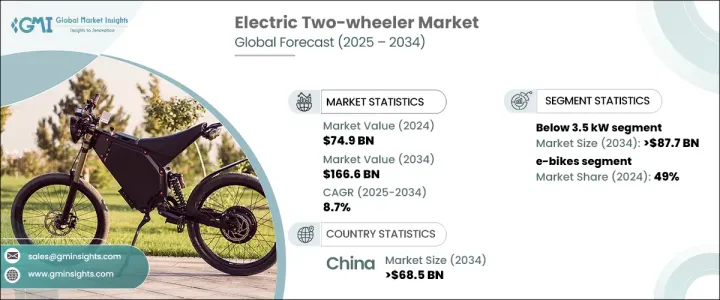
|
시장보고서
상품코드
1684766
세계의 전기이륜차 시장 : 기회, 성장 촉진요인, 산업 동향 분석, 예측(2025-2034년)Electric Two-wheeler Market Opportunity, Growth Drivers, Industry Trend Analysis, and Forecast 2025 - 2034 |
||||||
세계의 전기이륜차 시장은 2024년 749억 달러로 평가되어 2025년부터 2034년까지 8.7%의 연평균 복합 성장률(CAGR)로 견조하게 확대할 전망입니다.
수요의 급증은 친환경적인 운송 솔루션에 대한 주목 받고, 정부 인센티브, 도시 혼잡에 대처할 필요성 등 다양한 요인에 의해 뒷받침되고 있습니다. 세계가 이산화탄소 배출량을 줄이고 화석연료에 대한 의존도를 줄이려고 하고 있는 가운데, 전기이륜차는 소비자에게 합리적인 가격으로 효율적이고, 환경에 배려한 교통수단을 제공하는 중요한 솔루션이 되고 있습니다. 많은 국가들이 보조금과 세금을 환불하고 우대 정책을 내세우고 있기 때문에 이러한 전기 대체품은 보다 폭넓은 소비자에게 이용하기 쉬워지고 있습니다.

교통정체 증가로 컴팩트하고 효율적이고 편리한 교통수단에 대한 수요가 높아지면서 도시화는 시장성장 추진에 매우 중요한 역할을 하고 있습니다. 작고 부드러운 조작성, 혼잡한 도시 환경에서의 조종의 용이성으로 알려진 전기이륜차는 급속히 유력한 선택이 되고 있습니다. 또한, 집, 직장, 대중교통 역 사이의 간격을 메우기 위해 이러한 차량을 선택하는 사람들이 늘어나고 있기 때문에 라스트 원 마일 연결에서 이러한 차량에 대한 의존도가 높아지고 시장 확대에 박차를 가하고 있습니다. 전동 스쿠터와 렌탈 자전거를 포함한 공유 모빌리티 서비스의 성장은 전기이륜차의 보급에 더욱 기여하고, 주류의 교통 수단으로서의 역할을 높이는데 도움이 되고 있습니다. 전동모델이 합리적인 가격이 되고, 친환경 모빌리티의 이점에 대한 소비자의 의식이 높아짐에 따라, 시장은 지속적으로 성장하는 태세가 갖추어지고 있습니다.
| 시장 범위 | |
|---|---|
| 시작 연도 | 2024년 |
| 예측 연도 | 2025-2034년 |
| 시작 금액 | 749억 달러 |
| 예측 금액 | 1,666억 달러 |
| CAGR | 8.7% |
모터 출력에서 시장은 3.5kW 미만, 3.5 - 6.5kW, 6.5kW 이상의 세 가지 범주로 나뉩니다. 2024년에는 3.5kW 미만의 모터 출력이 54%의 점유율을 차지하고 시장을 독점했습니다. 이 카테고리는 2034년까지 877억 달러를 창출할 것으로 예상됩니다. 이러한 자동차는 저렴한 가격, 실용성, 도시 지역에서의 단거리 이동에 적합하기 때문에 매일 통근에 널리 선택되기 때문입니다. 주로 시가지와 교외에서 사용하기 위해 설계된 이러한 자동차는 성능과 비용의 균형이 절묘하고 예산에 민감한 소비자에게 특히 매력적입니다.
자동차 유형에는 전기 오토바이, 전기 스쿠터, 전기 자전거, 전동 킥스쿠터가 시장에 포함됩니다. 전기자전거는 2024년 시장 점유율의 49%를 차지했으며 그 매력은 계속 확대되고 있습니다. 합리적인 가격, 다용도 및 지속가능성의 융합을 제공하는 전기자전거는 도시의 통근자부터 레크리에이션 라이더에 이르기까지 광범위한 소비자를 끌어들이고 있습니다. 경량 설계, 페달 어시스트 기능 및 수명이 긴 배터리를 갖춘 전기자전거는 실용적이며 친환경적인 교통 수단을 원하는 사람들에게 인기있는 선택입니다.
중국은 계속 전기이륜차 시장을 선도하고 있으며, 2024년에는 48%의 점유율을 차지했습니다. 이 나라 시장은 2034년까지 685억 달러를 창출할 것으로 예상됩니다. 제조 생태계가 확립되고 전동 이동성 인프라에 대한 투자가 계속되고 있기 때문에 이 분야에서의 중국의 우위는 앞으로도 흔들릴 것으로 예상됩니다. 이 나라의 유리한 규제, 면세조치, 우대조치가 전기이륜차의 보급을 뒷받침하고 있어 세계 시장 최대의 기업이 되고 있습니다.
목차
제1장 조사 방법과 조사 범위
- 조사 디자인
- 조사 접근
- 데이터 수집 방법
- 기본 추정과 계산
- 기준연도의 산출
- 시장추계의 주요 동향
- 예측 모델
- 1차 조사와 검증
- 1차 정보
- 데이터 마이닝 소스
- 시장 정의
제2장 주요 요약
제3장 업계 인사이트
- 생태계 분석
- 기술 제공업체
- 부품 공급자
- OEM 제조업체
- 최종 사용자
- 공급자의 상황
- 이익률 분석
- 기술 혁신의 상황
- 주요 뉴스 및 이니셔티브
- 규제 상황
- 영향요인
- 성장 촉진요인
- 연료 가격 상승과 비용 효과
- 정부 인센티브와 정책
- 도시화와 라스트마일 모빌리티 수요
- 환경 의식의 고조와 지속가능성의 목표
- 업계의 잠재적 위험 및 과제
- 첨단 모델의 높은 초기 비용
- 제한된 충전 인프라
- 성장 촉진요인
- 성장 가능성 분석
- Porter's Five Forces 분석
- PESTEL 분석
제4장 경쟁 구도
- 소개
- 기업 점유율 분석
- 경쟁 포지셔닝 매트릭스
- 전략 전망 매트릭스
제5장 시장 추계 및 예측 : 2021-2034년 자동차별
- 주요 동향
- 전기 오토바이
- 전기 스쿠터
- 전기 자전거
- 전기 킥스쿠터
제6장 시장 추계 및 예측 : 배터리별, 2021-2034년
- 주요 동향
- SLA
- 리튬 이온
제7장 시장 추계 및 예측 : 모터 출력별, 2021-2034년
- 주요 동향
- 3.5kW 미만
- 3.5-6.5 kW
- 6.5kW 이상
제8장 시장 추계 및 예측 : 전압별, 2021-2034년
- 주요 동향
- 48V
- 60V
- 72V
- 기타
제9장 시장 추계 및 예측 : 지역별, 2021-2034년
- 주요 동향
- 북미
- 미국
- 캐나다
- 유럽
- 영국
- 독일
- 프랑스
- 스페인
- 이탈리아
- 러시아
- 북유럽
- 아시아태평양
- 중국
- 인도
- 일본
- 한국
- 뉴질랜드
- 동남아시아
- 라틴아메리카
- 브라질
- 멕시코
- 아르헨티나
- 중동 및 아프리카
- UAE
- 남아프리카
- 사우디아라비아
제10장 기업 프로파일
- Ampere Vehicles
- Ather Energy Pvt. Ltd.
- Bajaj Auto Ltd.
- Emflux Motors
- Giant Bicycles
- Gogoro Inc.
- Hero Electric Vehicles Pvt. Ltd.
- Jiangsu Xinri E-Vehicle Co. Ltd.
- Niu Technologies
- Ola Electric Mobility Pvt. Ltd.
- PURE EV
- Revolt Motors
- Super Soco
- Tork Motors
- TVS Motor Company
- Ultraviolette Automotive Pvt. Ltd.
- VMOTO SOCO Italy SRL
- Yadea Group Holdings Ltd.
- Yamaha Motor Company
- Zero Motorcycles Inc.
The Global Electric Two-Wheeler Market, valued at USD 74.9 billion in 2024, is expected to expand at a robust CAGR of 8.7% from 2025 to 2034. The surge in demand is being fueled by various factors, including the increasing focus on eco-friendly transportation solutions, governmental incentives, and the need to address urban congestion. As the world seeks to cut carbon emissions and reduce dependency on fossil fuels, electric two-wheelers have become a key solution, offering consumers an affordable, efficient, and environmentally conscious mode of transport. With many countries rolling out subsidies, tax rebates, and favorable policies, these electric alternatives are becoming more accessible to a broader consumer base.

Urbanization is playing a pivotal role in driving market growth, as rising traffic congestion intensifies the demand for compact, efficient, and convenient transportation solutions. Electric two-wheelers, known for their small size, smooth operation, and ease of maneuvering through crowded urban environments, are rapidly becoming the go-to choice. Moreover, the increasing reliance on these vehicles for last-mile connectivity is fueling market expansion as more people opt for them to bridge the gap between homes, workplaces, and public transportation stations. The growth of shared mobility services, including electric scooters and bikes for rentals, further contributes to the widespread adoption of electric two-wheelers, helping to elevate their role as a mainstream mode of transport. As electric models become more affordable and consumer awareness about the benefits of eco-friendly mobility grows, the market is poised for continued growth.
| Market Scope | |
|---|---|
| Start Year | 2024 |
| Forecast Year | 2025-2034 |
| Start Value | $74.9 Billion |
| Forecast Value | $166.6 Billion |
| CAGR | 8.7% |
In terms of motor power, the market is divided into three categories: below 3.5 kW, 3.5 kW-6.5 kW, and above 6.5 kW. The segment with motor power below 3.5 kW dominated the market in 2024, holding a 54% share. This category is expected to generate USD 87.7 billion by 2034, as these vehicles are widely chosen for daily commutes due to their affordability, practicality, and suitability for short urban trips. Designed primarily for city and suburban use, they strike a perfect balance between performance and cost, making them especially attractive to budget-conscious consumers.
Regarding vehicle types, the market includes electric motorcycles, electric scooters, e-bikes, and electric kick scooters. E-bikes represented 49% of the market share in 2024, with their appeal continuing to grow. Offering a blend of affordability, versatility, and sustainability, e-bikes attract a wide range of consumers-from urban commuters to recreational riders. With lightweight designs, pedal-assist capabilities, and long-lasting batteries, e-bikes have become a popular choice for those seeking a practical yet eco-friendly transportation solution.
China continues to lead the electric two-wheeler market, holding a 48% share in 2024. The country's market is expected to generate USD 68.5 billion by 2034, driven by a combination of strong domestic production, increasing consumer demand, and supportive government policies. With an established manufacturing ecosystem and ongoing investments in electric mobility infrastructure, China's dominance in the sector is expected to remain strong. The country's favorable regulations, tax exemptions, and incentives are encouraging the widespread adoption of electric two-wheelers, making it the largest player in the market globally.
Table of Contents
Chapter 1 Methodology & Scope
- 1.1 Research design
- 1.1.1 Research approach
- 1.1.2 Data collection methods
- 1.2 Base estimates and calculations
- 1.2.1 Base year calculation
- 1.2.2 Key trends for market estimates
- 1.3 Forecast model
- 1.4 Primary research & validation
- 1.4.1 Primary sources
- 1.4.2 Data mining sources
- 1.5 Market definitions
Chapter 2 Executive Summary
- 2.1 Industry synopsis, 2021 - 2034
Chapter 3 Industry Insights
- 3.1 Industry ecosystem analysis
- 3.1.1 Technology providers
- 3.1.2 Component suppliers
- 3.1.3 OEMs
- 3.1.4 End user
- 3.2 Supplier landscape
- 3.3 Profit margin analysis
- 3.4 Technology & innovation landscape
- 3.5 Key news & initiatives
- 3.6 Regulatory landscape
- 3.7 Impact forces
- 3.7.1 Growth drivers
- 3.7.1.1 Rising fuel prices and cost-effectiveness
- 3.7.1.2 Government incentives and policies
- 3.7.1.3 Urbanization and demand for last-mile mobility
- 3.7.1.4 Rising environmental awareness and sustainability goals
- 3.7.2 Industry pitfalls & challenges
- 3.7.2.1 High initial costs for advanced models
- 3.7.2.2 Limited charging infrastructure
- 3.7.1 Growth drivers
- 3.8 Growth potential analysis
- 3.9 Porter’s analysis
- 3.10 PESTEL analysis
Chapter 4 Competitive Landscape, 2024
- 4.1 Introduction
- 4.2 Company market share analysis
- 4.3 Competitive positioning matrix
- 4.4 Strategic outlook matrix
Chapter 5 Market Estimates & Forecast, By Vehicle, 2021 - 2034 ($Bn, Units)
- 5.1 Key trends
- 5.2 Electric motorcycle
- 5.3 Electric scooter
- 5.4 E-bikes
- 5.5 Electric kick scooter
Chapter 6 Market Estimates & Forecast, By Battery, 2021 - 2034 ($Bn, Units)
- 6.1 Key trends
- 6.2 SLA
- 6.3 Li-ion
Chapter 7 Market Estimates & Forecast, By Motor Power, 2021 - 2034 ($Bn, Units)
- 7.1 Key trends
- 7.2 Below 3.5 kW
- 7.3 3.5 kW – 6.5 kW
- 7.4 Above 6.5 kW
Chapter 8 Market Estimates & Forecast, By Voltage, 2021 - 2034 ($Bn, Units)
- 8.1 Key trends
- 8.2 48V
- 8.3 60 V
- 8.4 72V
- 8.5 Others
Chapter 9 Market Estimates & Forecast, By Region, 2021 - 2034 ($Bn, Units)
- 9.1 Key trends
- 9.2 North America
- 9.2.1 U.S.
- 9.2.2 Canada
- 9.3 Europe
- 9.3.1 UK
- 9.3.2 Germany
- 9.3.3 France
- 9.3.4 Spain
- 9.3.5 Italy
- 9.3.6 Russia
- 9.3.7 Nordics
- 9.4 Asia Pacific
- 9.4.1 China
- 9.4.2 India
- 9.4.3 Japan
- 9.4.4 South Korea
- 9.4.5 ANZ
- 9.4.6 Southeast Asia
- 9.5 Latin America
- 9.5.1 Brazil
- 9.5.2 Mexico
- 9.5.3 Argentina
- 9.6 MEA
- 9.6.1 UAE
- 9.6.2 South Africa
- 9.6.3 Saudi Arabia
Chapter 10 Company Profiles
- 10.1 Ampere Vehicles
- 10.2 Ather Energy Pvt. Ltd.
- 10.3 Bajaj Auto Ltd.
- 10.4 Emflux Motors
- 10.5 Giant Bicycles
- 10.6 Gogoro Inc.
- 10.7 Hero Electric Vehicles Pvt. Ltd.
- 10.8 Jiangsu Xinri E-Vehicle Co. Ltd.
- 10.9 Niu Technologies
- 10.10 Ola Electric Mobility Pvt. Ltd.
- 10.11 PURE EV
- 10.12 Revolt Motors
- 10.13 Super Soco
- 10.14 Tork Motors
- 10.15 TVS Motor Company
- 10.16 Ultraviolette Automotive Pvt. Ltd.
- 10.17 VMOTO SOCO Italy SRL
- 10.18 Yadea Group Holdings Ltd.
- 10.19 Yamaha Motor Company
- 10.20 Zero Motorcycles Inc.



















